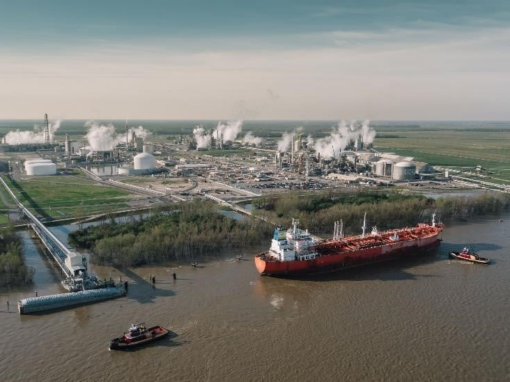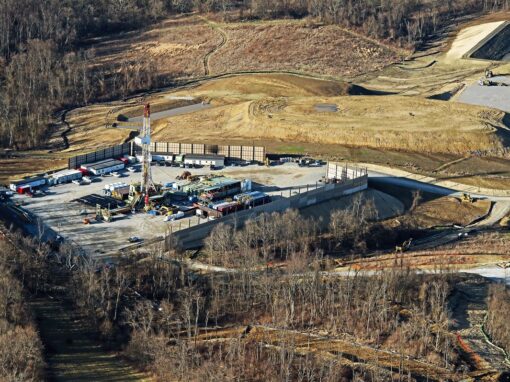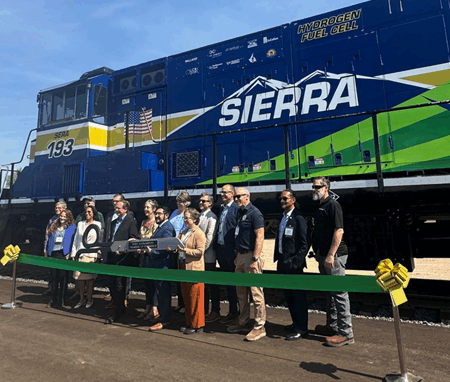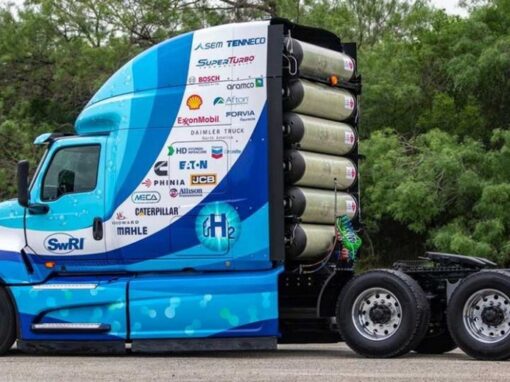July 8, 2025
By Charlie Sabgir
Fuel cell electric buses (FCEBs) have seen rapid growth in American public transportation since the passage of the Bipartisan Infrastructure Law (BIL), fueled by a surge in federal funding and local investment. Transit agencies are increasingly turning to hydrogen buses, and for good reason: FCEBs offer practical advantages over traditional diesel and battery-electric alternatives. As zero-emission vehicles, FCEBs eliminate pollution and the need for emissions control systems. They also offer shorter refueling times, long-range capacity, and enhanced performance in challenging weather conditions, while providing passengers with quieter, more comfortable experiences.
U.S. transit agencies laid the groundwork for hydrogen-powered fleets well before the BIL. SunLine Transit deployed a hydrogen fuel cell bus in 2003, becoming the world’s first public transportation agency to do so. As of August 2020, 64 FCEBs were in active service nationwide, with deployments in Hawaii, California, and Ohio. Since then, FTA’s Low or No Emission Grant (Low-No) Program–coupled with Inflation Reduction Act (IRA) incentives–has accelerated adoption.
Following the BIL’s passage in 2021, Low-No funding rose from $182 million in FY21 to $1.66 billion in FY22, nearly $1.7 billion in FY23, and approximately $1.5 billion in FY24. The latest funding round will support the purchase of over 1,100 American-made buses across 47 states, with nearly 80% of the 117 awards prioritizing zero- and low-emission vehicles. About half of the projects will also upgrade facilities to accommodate these fleets. While hydrogen and fuel cell projects account for a small share of overall Low-No funding, the FY24 projects highlighted below all incorporate the acquisition of FCEBs. Several also support related initiatives such as refueling stations, workforce development, and other infrastructure improvements.
California’s transit agencies continue to lead the nation in FCEB adoption. In FY24, the Sacramento Regional Transit District secured $76.8 million to help achieve its target of a zero-emission fleet by 2028. Meanwhile, the Western Contra Costa Transit Authority (WestCAT) and AC Transit received $20.6 million and $15 million, respectively, to advance their own zero-emission efforts in the Bay Area.
The Midwest is also scaling up its investment in FCEBs. Detroit’s Department of Transportation and Ann Arbor’s Transportation Authority received $30.8 million and $25 million, respectively, to modernize their fleets and build refueling stations. Ohio is emerging as a leader in the space– the Stark Area Regional Transit Authority (SARTA) will use its $17.2 million from FY24 to expand what is already the nation’s fourth-largest hydrogen fleet, while the Central Ohio Transit Authority (COTA) received $22.8 million in FY24 to deploy battery and fuel cell buses as part of Columbus’s vision for a zero-emission fleet by 2035. In Indiana, the Greater Lafayette Public Transportation Corporation is utilizing FTA grants from 2023 and 2024 to install a hydrogen refueling station and roll out hydrogen buses by 2025.
The Pacific Northwest is ramping up investment as well. In FY24, Washington’s Island Transit obtained approximately $15 million to deploy FCEBs to Whidbey Island, while Oregon’s Tri-County Metropolitan Transportation District received $39 million to purchase hydrogen buses and implement a portable fueling station.
In New York, Rochester-Genesee Regional Transportation Authority (RTS) introduced the state’s first FCEBs in October 2024, citing battery-electric performance issues in the region’s harsh climate. RTS secured an additional $18.1 million for FY24 to expand its hydrogen fleet and upgrade facilities as annual ridership climbs back towards 10 million trips.
South Carolina’s Central Midlands Regional Transit Authority (The COMET) is beginning to see tangible results from earlier Low-No funding. In early 2024, the COMET rolled out two New Flyer fuel cell electric buses (FCEBs), made possible by a $2.9 million grant awarded in 2021. These buses offer a 370-mile range on a single fill and can be refueled in under 20 minutes, marking a significant step forward in zero-emission transit for the region.
FCHEA members are bridging the gap between ambition and implementation by developing the advanced technologies transit agencies need.
Ballard Power Systems is at the forefront, supplying PEM fuel cell engines to support the rollout of FCEBs across the U.S. In November 2024, the company announced it would double its earlier 2024 order, supplying 200 engines, equivalent to approximately 20 MW of power, to New Flyer. Ballard has expanded its US manufacturing facilities in Bend, OR, to meet growing demand. This expansion, according to Ballard CCO David Mucciacciaro, reflects “continued confidence” in their technology and a “growing market proposition” for FCEBs. These engines will power New Flyer’s Xcelsior CHARGE FC™ buses in Arizona, California, Nevada, New York, and Washington, with the rollout planned for 2025.
Ballard’s footprint extends beyond North America. In April 2024, it secured the largest fuel cell engine supply order in its history through an agreement with Solaris to deliver approximately 1,000 fuel cell engines. In March 2025, Ballard announced a multi-year deal with Egyptian commercial vehicle manufacturer MCV to supply 50 FCmove®-HD+ hydrogen fuel cell engines. Deliveries, scheduled for 2025 and 2026, will primarily support projects in the EU.
Accelera™ by Cummins is advancing the FCEB sector with its 300 kW and 150 kW fuel cell engines. These engines’ fuel cell stacks and systems offer high power capabilities that support long-distance travel. Additionally, the integration of variable pressure and external humidifiers ensures optimal performance across diverse weather conditions. Accelera’s engines are particularly suited for coach buses, complementing urban transit applications.
Hyundai Motor is hitting major milestones as well. In September 2024, its Elec City FCEV hydrogen buses surpassed 1,000 units sold– a significant achievement for the company and industry. Launched in 2019, the 180 kW Elec City FCEV was engineered for high-demand long-distance routes and high-traffic areas. Hyundai followed the Elec City in 2023 with the Universe FCEV, a high-speed hydrogen-powered vehicle.

Hyundai ELEC CITY Fuel Cell (Source: Hyundai)
Whether tackling long-distance routes or operating in tough weather conditions, FCEBs provide compelling advantages for riders, transit staff, and the surrounding community. As transit agencies increasingly adopt hydrogen-powered buses for cleaner, more efficient service, FCHEA members will continue to lead the way. The Low-No Grant Program will remain instrumental in incentivizing and accelerating the transition to sustainable public transportation.



